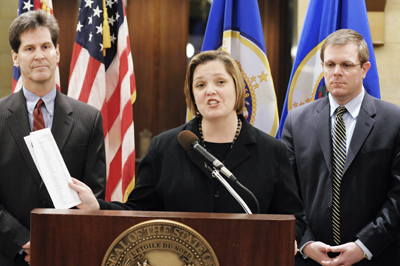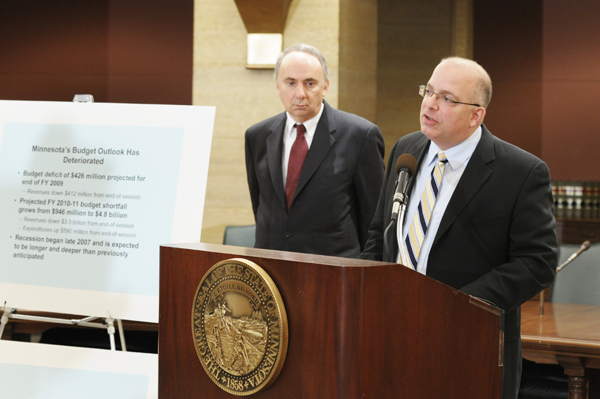First Reading: Deep in the red
By Mike Cook
 Optimism that traditionally comes with the start of a new legislative biennium is overshadowed this year by a large red cloud.
Optimism that traditionally comes with the start of a new legislative biennium is overshadowed this year by a large red cloud.
Hanging over the collective legislative heads is a projected $4.85 billion deficit for the 2010-2011 biennium, which begins July 1, 2009.
Members may also yet have to resolve another short-term fiscal crisis if the February Forecast provides more negative numbers, as many people anticipate.
It will not be an easy session for members who campaigned on things like increased education funding, better health care access or keeping taxes and levels of program support at current levels.
Answers must be finalized by May 18, the constitutional deadline for adjournment.
Why so far in the hole?
Minnesota is not alone in its monetary woes as policymakers across the country face some historical challenges. According to the Center on Budget and Policy Priorities, “Budget deficits are already projected in 38 states for the upcoming fiscal year. Initial estimates of these shortfalls total almost $80 billion. As the full extent of 2010 deficits becomes known, shortfalls are likely to equal $145 billion.”
The problem in Minnesota is $31.87 billion in anticipated biennial revenues in fiscal years 2010-2011, but $36.7 billion in expenses.
Unlike the ever-growing federal deficit, the state cannot carry a budget deficit into a future biennium.
 “We cannot print Monopoly money in the basement,” Gov. Tim Pawlenty said. “The books have to balance.”
“We cannot print Monopoly money in the basement,” Gov. Tim Pawlenty said. “The books have to balance.”
The shortage comes from a number of factors, State Economist Tom Stinson said Dec. 4. In addition to the national recession, he cited the dismal housing sector, the “massive loss of wealth” from the declining stock market, consumer lack of confidence, decreased tax revenue collections and greater unemployment numbers. At the time, he said Minnesota had lost about 20,000 jobs and could lose about 58,000 more by the end of 2009.
Current biennium problems
The $271.6 million unallotment, announced Dec. 19 by Pawlenty, is the final step in resolving the state’s anticipated $426 million shortfall for the current fiscal year, which ends June 30, 2009. The remaining $154.9 million comes from draining the state’s budget reserve.
Included in the unallotment is $110 million in aid and credit reductions to cities and counties; $73 million cut in human services spending; $40 million from higher education, evenly split between the University of Minnesota and the Minnesota State Colleges and Universities system; and $40 million from state agency unexpended operating budgets. Military and veterans programs, K-12 education and public safety programs were protected.
Senate Majority Leader Larry Pogemiller (DFL-Mpls) unsuccessfully suggested an across-the-board 1.6 percent reduction in state program funding.
More than a dozen local government leaders came to the Capitol in early December, claiming their jurisdictions couldn’t cope with any state funding cuts.
“These are modest reductions that local government should be able to handle without impacting key services like public safety,” Pawlenty said, noting that 60 percent of cities did not experience a reduction. “Any city councilmember, any mayor, any city administrator that says their first course of action is going to be to affect public safety, I would politely suggest to them that they have misplaced priorities.”
House Speaker Margaret Anderson Kelliher (DFL-Mpls) said, “The reality is many cities and towns are in tough financial shape. … Trying to nuance around the small cities and towns is good.”
But the bleeding may not yet be over for the current biennium.
Stinson told the Senate Taxes Committee Dec. 10 that the state could be $30 million to $70 million further in debt because of higher-than-anticipated national unemployment numbers released five days earlier. Updated figures are expected with the release of the February Forecast, which traditionally happens the final week of that month.
“The question then will be if Democrats are capable of cutting or if the governor will again have to unallot for a second time,” House Minority Leader Marty Seifert (R-Marshall) said in a statement.
More difficult than before
This is not the first time the Pawlenty administration has had to deal with a massive projected shortfall. The 2003 Legislature — the first with Pawlenty as governor — faced a projected $4.56 billion shortage for the ensuing biennium. That problem was resolved using spending cuts; fee increases; using state reserves, including $1 million from a tobacco endowment fund; and some accounting shifts, such as delaying payments to schools.
“We’ll be looking at the budget to find things that work and eliminate things that don’t,” said House Majority Leader Tony Sertich (DFL-Chisholm). “Government needs to be accountable and responsible. We have a vision for a better Minnesota and we are determined to work cooperatively with the governor to set the right priorities to achieve that goal.”
Three Republicans have already put forth a couple of proposals.
Rep. Paul Kohls (R-Victoria) suggested state spending be frozen at the lesser of current levels or predicted revenues. Rep. Laura Brod (R-New Prague) and Sen. Geoff Michel (R-Edina) said the state should lease the Minneapolis-St. Paul International Airport and state lottery to private investors with transaction proceeds dedicated to scholarships and other education initiatives. They noted Midway Airport in Chicago was privatized last year for $2.5 billion, and a dozen other states are looking to privatize lottery operations.
Pawlenty, who hopes to again keep military and veterans programs, K-12 education and public safety programs safe, is to announce his 2010-2011 biennial budget by Jan. 27. He said it would not contain tax increases.
“This is not a time to be adding burdens on the people of Minnesota with tax burdens,” he said at a Dec. 9 Associated Press forum. “Unfortunately, the Legislature didn’t follow that the last two years. They added $8 billion of tax increases on the people of Minnesota over the next four years. … I would say that’s enough, more than enough.”
Kelliher said the DFL plans to take the governor’s budget proposal around the state for “full and fair hearings” before offering its budget proposal.
“This is a crisis Minnesotans will need to be involved with as well. We will come out on the other side of it in a much stronger position if the public of Minnesota is involved with us,” she said at the forum. “Where we agree with the governor, we will immediately work to try to pass and enact changes. Where the public disagrees, we will listen to some of their ideas and solutions for how to solve the budget problem.”
At the forum, Seifert said Republicans prefer earlier budget targets to a “misery tour” followed by a final-week rush to past spending bills.
“I think we need to be thoughtful and we need to be proactive. We should try to get our cards on the table very early so we can have that discussion in the Legislature front-loaded and then move forward.”
Effect on planned programs
A few House committees took to the road during the interim to share ideas and receive feedback on potential changes.
For example, the House K-12 Education Finance Division held a series of public hearings across the state about possible education funding reform. Rep. Mindy Greiling (DFL-Roseville), the division chairwoman, said a bill dubbed the “New Minnesota Miracle” is to be introduced Jan. 12.
“The plan can be phased in over three bienniums, so I’ll be happy to just get started in some significant way,” she said. “I’m not expecting a third of it. … We don’t need $500 million to start.”
Greiling believes that you should make strategic investments while cutting and doing things differently; therefore, the plan is scaled in such a way that it can be implemented based on the funding received. “If we get a tenth of what we need, then a tenth is the new formula and 90 percent is the old formula.”
Session Weekly More...
Related Stories
A done deal
Budget fix makes the best of bad times for the state
(view full story)
Published 6/1/2010
Deal or no deal?
Endgame is unclear as budget talks enter final days
(view full story)
Published 5/13/2010
Unallotment undone
Court decision throws governor, lawmakers a curveball
(view full story)
Published 5/6/2010
Budget cuts, round one
Despite deep spending cuts, legislators try to soften the blow
(view full story)
Published 4/8/2010
Closing the gap
Piece by painful piece, lawmakers begin chipping away at the budget deficit
(view full story)
Published 3/18/2010
A cloudy forecast
State’s new economic projection shows more trouble on the horizon
(view full story)
Published 3/4/2010
Budget battle begins
DFL lawmakers say governor’s budget plan is incomplete, call for ‘Plan B’
(view full story)
Published 2/18/2010
Minnesota Index: The state budget
Figures and statistics on Minnesota's state budget
(view full story)
Published 2/18/2010
Cash flow conundrum
Projected cash shortages will require delicate balancing act
(view full story)
Published 2/11/2010
First Reading: From worse to bad
Stimulus helps, but lawmakers still face a record deficit
(view full story)
Published 3/6/2009
First Reading: 'Tough decisions'
Governor proposes spending cuts, accounting shifts to solve $4.8 billion deficit
(view full story)
Published 1/30/2009
At Issue: Been there, done that
House finance chair, former governor reflect on previous budget problem
(view full story)
Published 1/30/2009
At Issue: Not enough money in the cookie jar
Spending to outpace revenues as state’s population ages, report finds
(view full story)
Published 1/16/2009
First Reading: Deep in the red
Members begin session with multi-billion dollar deficit to overcome
(view full story)
Published 1/9/2009
At Issue: Starting from zero
Lawmakers consider a new approach to building the state budget
(view full story)
Published 1/9/2009